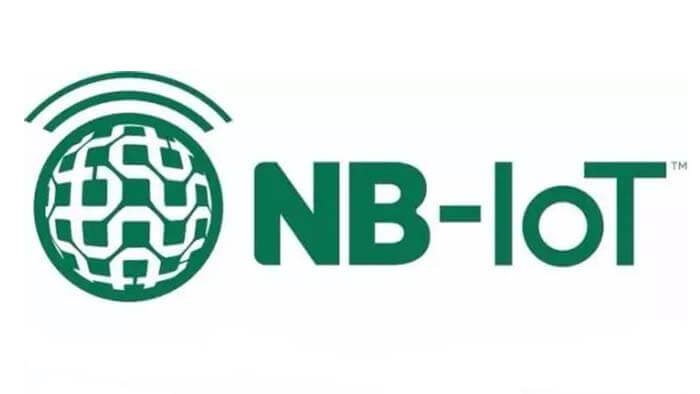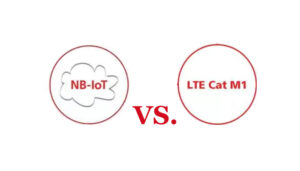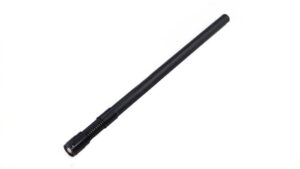NB-IoT (Narrowband IoT) is a low-power technology designed for Internet of Things (IoT) applications and other low-data rate communication requirements.
It uses narrowband radio spectrum and advanced power management techniques to efficiently utilize the available spectrum and extend the battery life of IoT devices.
NB-IoT is based on LTE cellular wireless technology and has been standardized by the 3rd Generation Partnership Project (3GPP) as the global wireless communication standard for IoT applications.
What is Narrowband IoT(NB-IoT)?
NB-IoT is a Low Power Wide Area Network ( LPWAN ) technology designed for Internet of Things (IoT) devices and other applications that require low data rates and long battery life. It is a cellular network technology that uses a narrowband radio spectrum to provide secure and reliable communications for IoT devices.
NB-IoT operates in a licensed spectrum and uses advanced modulation and multiple access techniques to efficiently utilize the available spectrum and support many connected devices.
It also uses advanced power management techniques to extend the battery life of IoT devices, which is critical for applications such as remote sensors and other devices that are not easily maintained or replaced with batteries.
In addition to low power consumption and remote capabilities, narrowband IoT offers higher security and reliability than other IoT technologies.
It uses a dedicated network infrastructure and robust signaling mechanisms to provide reliable communications, even in challenging environments such as dense urban areas or deep underground.
Narrowband IoT is a key technology for enabling the Internet of Things and supporting the growing number of connected devices deployed in various industries, from agriculture and manufacturing to smart cities and healthcare.
What is the narrowband IoT band range?
Narrowband IoT is a radio technology standard used to support a wide range of cellular devices and services developed by the Third Generation Partnership Project (3GPP). The technology coexists with Global System for Mobile Communications (GSM) and Long Term Evolution (LTE) in licensed frequency bands (e.g., 700 MHz, 800 MHz, and 900 MHz).
However, NB-IoT limits the bandwidth to a single narrowband at 180 kHz and the bit rate to 150-250 kbps. Narrowband IoT mostly uses 2G/3G/4G/5G cellular communication technologies supported by the International Organization for Standardization 3GPP in the sub-1 GHz licensed band shared with cellular communications.
What is the architecture of the NB-IoT network?
The overall NB-IoT network architecture is divided into 5 parts: terminal, wireless network side, core network side (EPC), IoT support platform, and application server.
Introduction to NB-IoT network architecture.
NB-IoT terminal
It is mainly connected to the base station through the airport. The terminal side mainly contains the industry terminal and NB-IoT module. Industry terminal includes: chip, module, sensor interface, terminal, etc.; NB-IoT module includes wireless transmission interface, soft SIM device, sensor interface, etc.
Wireless network side
The wireless network side includes two types of networking: Single RAN (Single Radio Access Network, integral radio access network), which includes 2G/3G/4G and NB-IoT wireless network; the other NB-IoT new construction. It mainly undertakes airport access processing, cell management, and other related functions. It connects to the IoT core network through the S1-lite interface, forwarding non-access layer data to higher-level network elements for processing.
Core network side
Network elements include two types of networking. One is the overall Evolved Packet Core Network (Evolved Packet C data transmission method, welcome to exchange and learn together ore, EPC) network elements, including 2G/3G/4G core network; the other is the IoT core network. The core network side supports NB-IoT and eMTC user access through IoT EPC network elements and EPC shared by GSM, UITRAN, and LTE.
IoT support platform
The IoT support platform includes HLR (Home Location Register, attributed location register), PCRF (Policy Control and Charging Rules Function, Policy Control and Charging Rules Function Unit), and M2M (Machine to Machine, Internet of Things) platform.
Application Server
The application server is the final aggregation point of IoT data and performs data processing and other operations according to the customer’s needs.
How does Narrowband IoT data transmission?
Cellular IoT (CIoT) defines two optimization schemes in EPS to send IoT data to applications.
CIoT EPS user-plane functional optimization (User Plane CIoT EPS optimization)
CIoT EPS control plane functional optimization (Control Plane CIoT EPS optimization)
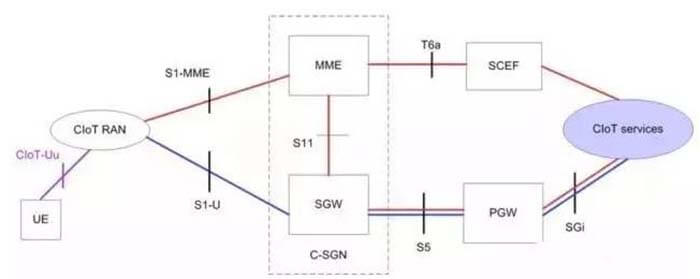
As shown in the figure above, the red line indicates the CIoT EPS Control Plane functional optimization scheme, and the blue line indicates the CIoT EPS User Plane functional optimization scheme.
What are the advantages of NB-IoT network architecture?
Strong link
With the same base station, NB-IoT can provide 50-100 times more access than existing wireless technologies. One sector is capable of supporting 100,000 connections, supporting low latency sensitivity, low device power consumption, and optimized network architecture.
Wide coverage
NB-IoT has strong indoor and basement coverage capability, with a 20dB gain compared to LTE, equivalent to a 100x increase in coverage area capability. It can meet the demand for wide coverage in rural areas and applications such as factories, underground garages, and manhole covers that require in-depth coverage. Take manhole cover monitoring as an example.
In the past, GSM/GPRS method needed to extend an antenna, which is easily damaged by vehicles coming and going, while NB-IoT can solve this problem well as long as it is deployed properly. Four Trust NB-IoT modules have solutions for smart manhole cover monitoring and provide equipment and solutions for many cities.
Low power consumption
Low power consumption is an important indicator requirement for IoT applications, especially for some devices and occasions where batteries cannot be replaced frequently, such as various types of sensing and monitoring devices placed in remote areas in high mountains and wilderness and power voltage monitoring devices which cannot be charged like smartphones one day, so the battery life of up to several years is the essential requirement.
Therefore, the power consumption of NB-IoT devices can be very small, and the working time of the device life can be significantly increased from several months in the past to several years.
Low cost
Compared with LoRa, NB-IoT does not need to rebuild the network, and RF and antenna are reused. Take China Mobile as an example, there is a relatively wide frequency band inside 900MHz, and only a part of the 2G band needs to be cleared out so that LTE and NB-IoT can be deployed simultaneously directly. Low rate, low power consumption, and low bandwidth also bring low-cost advantages to NB-IoT chips and modules.
Is narrowband IoT secure?
Because the underlying technology is less complex than traditional cellular modules, OEMs can more easily design, produce and deploy their products. The same proven security and privacy protections of LTE mobile networks are also available, including support for:
User identity confidentiality;
Physical authentication;
Data integrity;
Mobile device identification.
Narrowband IoT Applications
IoT applications have great opportunities to transform the way enterprises and cities create broad social and economic benefits. Still, secure and stable connectivity is predicated on capturing all potential narrowband IoT applications for innovation and cooperation.
Narrowband IoT end-to-end solutions for typical M2M application scenarios, such as low data rates, many terminals, and wide coverage requirements, can open up a broad IoT market for operators. At the same time, there is a wide range of application scenarios in government and enterprise industry sectors, such as smart cities and power and gas/water service providers.
NB-IoT Use Case Requirements
NB-IoT can meet the needs of many IoT use cases because of:
Efficiency
NB-IoT uses half-duplex communication, meaning neither the module nor the cellular base station can transmit data simultaneously. This use of half-duplex communication, along with slower NB-IoT data rates, use of a single antenna, and lower radio frequency (RF) bandwidth, minimizes the complexity of NB-IoT devices and thus reduces costs. These simplifications reduce the cost of NB-IoT modules by up to 50% compared to standard LTE Cat-1 cellular modules.
Power consumption
Thanks to Power Save Mode (PSM) and eDRX (Extended Discontinuous Reception), and NB capacity IoT, optimized for small data transfers, battery-powered edge modules can transmit data with up to 75% less power than standard LTE Cat-1 modules. As a result, manufacturers of IoT applications can create gadgets with a battery life of ten years or more.
Greater capacity
Up to 1 million NB-IoT devices can be connected per square kilometer thanks to narrowband transmission, signaling optimization, adaptive modulation, and Hybrid Auto-Repeat Request (HARQ) technology.
Better coverage
Narrowband IoT utilizes a large number of signal repetitions. Compared to competing for cellular technologies, large signal repetition enhances NB coverage of IoT by a factor of 5-10. However, it reduces data throughput and increases power consumption. Because of this improved coverage, NB-IoT devices can now connect to cellular networks, even underground, inside buildings, or rural areas.
What is the cost of NB-IoT?

The cost of Narrowband IoT can vary depending on several factors, including the specific implementation, the types of devices and infrastructure used, and the deployment size. Therefore, it isn’t easy to provide an accurate cost estimate for NB-IoT.
The cost of implementing NB-IoT may include purchasing and installing the necessary equipment and infrastructure, such as base stations, antennas, and other hardware. It can also include the cost of operating and maintaining the network and purchasing or leasing the necessary spectrum.
In addition, the cost of NB-IoT may also depend on the type of deployments, such as a standalone NB-IoT network or a network integrated with an existing cellular network. Costs may also vary depending on the deployment size, with larger deployments typically requiring more equipment and infrastructure.
The cost of implementing NB-IoT will depend on various factors and may vary depending on the specific implementation and requirements.
Is NB-IoT bi-directional?
NB-IoT is a bi-directional communication technology that supports uplink and downlink communication. In bi-directional communication, data can be transmitted from the device to the network (uplink) and from the network to the device (downlink), thus enabling bi-directional communication.
This is in contrast to unidirectional communication, where data can only be transmitted in one direction (from the device to the network or from the network to the device).
Narrowband IoT uses advanced multiple access technologies such as Time Division Multiple Access (TDMA) and Frequency Division Multiple Access (FDMA) to use available spectrum and support bi-directional communication efficiently.
This allows IoT devices to send data to and receive data from the network, enabling a wide range of applications, such as remote sensor monitoring, asset tracking, and other IoT use cases.
The bi-directional communication capabilities of NB-IoT are an important part of its design, enabling a wide range of IoT applications.
Narrowband IoT and Massive IoT
In practice, we will often hear comparisons between NB-IoT and LTE-M, even though these are the two options promoted by the mobile industry ecosystem of manufacturers, service providers, and network operators. Let’s say you’ve never heard of LPWAN, or others have described it as something new.
In that case, it’s not because it falls into an entirely new category of wireless IoT communications but because cellular LPWA networks are finally being deployed in many regions after long delays caused primarily by the various competing technologies and services being proposed to the mobile industry made the decision.
Massive IoT, another industry term, refers to “billions” of devices that typically transmit small amounts of data, often at intervals (and therefore not continuously, but occasionally), and require long battery life like NB-IoT IoT and others, and is sometimes used to classify LPWAN.
Before discussing specifications, use cases, innovations, and other topics, a brief introduction to standards and standardization may be helpful if there is interest in certain details.
The mobile (cellular) industry’s standardization body, 3GPP, uses numbered “releases” where details of new standards and improvements are set at specific points in time. These updates include many mobile technologies developed by members of the mobile industry.
Is NB-IoT 5G or 4G?
Narrowband IoT is not considered a 4G or 5G technology. It is a Low Power Wide Area Network (LPWAN) technology designed for Internet of Things (IoT) applications and other low data rate communication requirements.
4G and 5G are cellular network technologies that deliver high-speed mobile broadband and other advanced communications services to mobile devices such as smartphones and tablets.
These technologies use broadband radio spectrum, advanced modulation, and multiple access technologies to support high data rates and many connected devices.
In contrast, NB-IoT is designed to support low data rates and long battery life for IoT devices and other applications without high data rates and features of 4G or 5G. It uses narrowband RF spectrum and advanced power management techniques to efficiently utilize the available spectrum and extend the battery life of IoT devices.
While 4G and 5G are focused on providing high-speed mobile broadband services, NB-IoT is designed to support a wide range of IoT applications and drive the growth of IoT.
What's the difference between NB-IoT and LTE?
NB-IoT (Narrowband IoT) and LTE are wireless communication technologies, but they are designed for different purposes and have some key differences.
Narrowband IoT is a Low Power Wide Area Network (LPWAN) technology designed for Internet of Things (IoT) applications and other low data rate communication requirements.
It uses narrowband RF spectrum and advanced power management techniques to efficiently utilize the available spectrum and extend the battery life of IoT devices.
In contrast, LTE is a cellular network technology that provides high-speed mobile broadband and other advanced communication services to mobile devices such as smartphones and tablets.
It uses broadband radio spectrum, advanced modulation, and multiple access technologies to support high data rates and many connected devices.
Some of the key differences between NB-IoT and LTE include the following:
Data rates
NB-IoT is designed for low data rate applications and can support data rates of up to 200 kbps, while LTE can support up to hundreds of Mbps.
Spectrum
NB-IoT operates in the licensed spectrum, while LTE can operate in both licensed and unlicensed.
Range
NB-IoT has a longer range than LTE due to the use of narrowband spectrum and advanced power management techniques.
Power consumption
NB-IoT is designed for low power consumption and long battery life, while LTE devices typically have higher power requirements.
LTE is focused on providing high-speed mobile broadband services, while NB-IoT is designed to support a wide range of IoT applications and drive the growth of IoT.
Narrowband IoT VS. LoRa
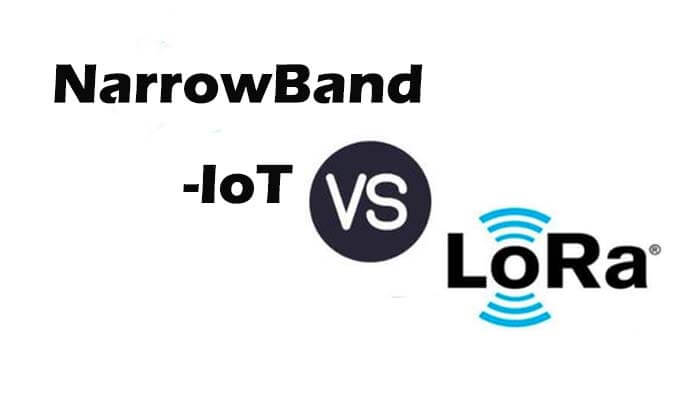
NB-IoT (Narrowband IoT) and LoRa are both Low Power Wide Area Network (LPWAN) technologies designed for Internet of Things (IoT) applications and other low data rate communication requirements.
They both use narrowband radio spectrum and advanced power management techniques to efficiently utilize the available spectrum and extend the battery life of IoT devices.
There are some key differences between NB-IoT and LoRa, including the following:
Spectrum
Narrowband IoT operates in the licensed spectrum, while LoRa can operate in both licensed and unlicensed.
Data rate
NB-IoT can support data rates up to 200 kbps, while LoRa can support data rates up to 50 kbps.
Range
Due to proprietary spread spectrum modulation technology, Lora has a longer range than narrowband IoT.
Power consumption
NB-IoT is designed for low power consumption and long battery life, while LoRa devices typically have higher power requirements.
Network Infrastructure
Narrowband IoT uses a dedicated network infrastructure, while LoRa uses a distributed network architecture with decentralized control.
While both NB-IoT and LoRa are designed for low-data rate IoT applications, some key differences exist in their technical implementation and functionality.
Latency of NB-IoT

Compared to LTE-M, narrowband IoT is less suited for situations where very low network latency is required. As a result, it is not commonly used in applications that require near real-time data. In these cases, LTE-M is more suitable.
NB-IoT and LTE-M play a role in the development of 5G, where very low network latency is essential for applications where speed is needed and often critical. The choice of communication standard is not the only factor to consider here.
In addition to the differences in network latency between NB-IoT and LTE-M, it is worth noting that edge computing and IoT can also play a role in the rapid analysis of sensor data. Edge computing allows for data analysis closer to the source without communicating with the cloud or data center.
The latency of NB-IoT specifically is typically equal to or less than 10 seconds, ranging from 1.6 to 10 seconds. In comparison, LTE-M has a latency of 100 to 150 ms.
Mobility for NB-IoT
A key difference between NB-IoT and LTE-M is that NB-IoT does not fully support mobility, while LTE-M does. This means narrowband IoT may not be as effective when switching between cells is required. However, this has been improved in 3GPP Release 14 with some enhancements to the features of NB-IoT.
In contrast, LTE-M also supports voice. Despite the limitations of NB-IoT in terms of mobility, it is still widely used in applications and cases involving fixed assets and devices. This is evident in the application types and uses cases mentioned earlier.
It is important to note that this does not mean that NB-IoT cannot be used for mobile assets and devices but has limited capabilities in this area.
There are real-world NB-IoT applications with trackers, shared bicycle services, environmental applications with mobile components but low data throughput, smart logistics, etc.
More specifically, narrowband IoT requires devices to periodically reselect cells while in motion, whereas LTE-M does not. It is, therefore, less suitable for mobile devices (and cell reselection affects battery life as it consumes power).
Fixed assets such as smart meters and point-of-sale terminals are often the focus of NB-IoT, although they are not the only focus. For “truly seamless mobility,” LTE-M can be considered the technology of choice.
The Future of NB-IoT Applications
Affordable modems are essential for the widespread deployment of sensors. There is a need to improve monitoring procedures and report various variables, such as temperature and humidity.
Data rates and latency should be reduced for applications involving a large number of sensors. The fact that the solution can meet these criteria supports the claim that NB-IoT will improve efficiency.
For single-tone devices, narrowband IoT devices have shown that they can handle peak physical layer data rates down to 100-200kbps or even lower.
We can also look at other aspects of device optimization. For example, LTE MBB requires two antennas, while NB-IoT devices require only one receive antenna.
Therefore, the ratio and baseband demodulator requires only one receiver chain. One benefit of narrow bandwidth is the difficulty of analog-to-digital and digital-to-analog conversion, channel estimation, and lower buffering (200 kHz for NB-IoT versus 1.4 MHZ to 20 MHZ for other technologies).
Agriculture
Thanks to narrowband IoT connectivity, farmers will have advanced tracking options, so sensors with NB-IoT modules can send alerts when animals move abnormally. These sensors can track environmental features, including pollution, noise, rain, and soil characteristics, such as temperature and humidity.
Smart metering
Gas and water meter monitoring can be accomplished using frequent, tiny data transmissions using NB-IoT. The rollout of smart meters faces significant network coverage challenges. Meters are often found in challenging locations, such as cellars, underground tunnels, or remote rural areas. For this problem, NB-IoT has outstanding coverage and penetration capabilities.
Smart Cities
Local governments can use narrowband IoT to manage street lights, determine when garbage cans need to be emptied, locate vacant parking spaces, keep an eye on the weather, and assess road conditions.
Smart Buildings
Sensors with NB-IoT connectivity can manage lighting and temperature and transmit notifications about building maintenance issues.
In addition, narrowband IoT can serve as a backup broadband connection for buildings. In some security solutions, sensors can connect directly to monitoring systems using LPWA networks, as this configuration is easier to install and maintain and more difficult for intruders to disable.
Consumer
Wearable technology will receive remote connections via NB-IoT, particularly useful for tracking people and animals. Similarly, NB-IoT tracks the health of people with age or chronic-related conditions.
Besides this article, you may also be interested in the below articles.
PCB Antenna VS. External Antenna
Ceramic Antenna VS. PCB Antenna, A Comparison Guide
Wifi vs. 5G, is 5G better than Wifi?
Mobile Networks’ Evolution From 1G To 5G
How To Choose Embedded Antenna For IoT?

